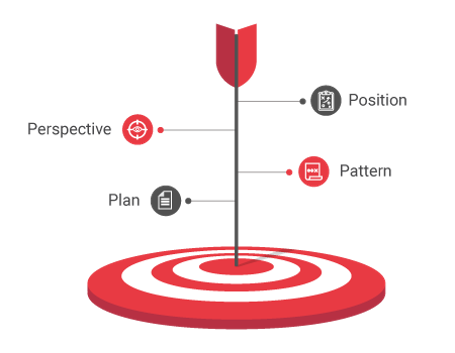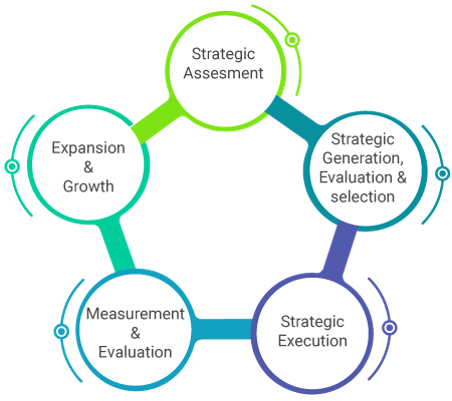
Strategy management for IT services is a process of defining and maintaining the perspective, position, plans, and patterns (which constitute the 4 Ps) of an organization with regards to its services and management of those services. The purpose of strategy management for IT services is to make sure that a strategy is defined properly, maintained, and managed adequately to achieve its purpose.
Objectives of Strategy Management for IT Services
The objectives of strategy management for IT services include the following:
- A statement that clearly expresses the vision and mission of the service provider, which is reviewed on a regular basis. This constitutes the perspective of the service provider.
- A proper definition of the services that will be provided by the service provider, to what market spaces they will be provided to, and the strategies by which the competitive advantage of the service provider will be maintained. This constitutes the position of the service provider.
- The production, communication, and maintenance strategic planning documents of the service provider. This constitutes the plans of the service provider.
- A definition of how exactly the service provider will consolidate itself to allow the business objectives to be met. This is a pattern of the service provider. An organization works because of a pattern of action.
Scope of Strategy Management for IT Services
- The responsibility of strategy management falls on the executives of an organization, and it allows them to set the objectives of the organization. The executives also have to mention exactly how the organization will meet those objectives and prioritize the investments required to meet those objectives.
- The strategy of an organization is not limited to a single document or department. The organization’s overall strategy is broken down into separate strategies for each business unit in the organization.
- It is the duty of strategic management of the organization to make sure that the individual business strategies for the business units are consistent and linked to one other.
- Strategy management for IT services also has to ensure that the services and their way of management support the overall strategy of the organization.
- The IT strategy and IT service strategy are usually derived from the business strategy of the organization and validate the business strategy as well.
- The IT strategy is capable of determining the technical feasibility of a strategic objective and the level of investments that would be needed to meet that objective.
- Based on these reports, the organization will be able to decide whether or not the objective should be included and whether it should be prioritized.
Basic Concepts of Strategy Management for IT Services
It is important first to understand that a service strategy is not the same as an ITSM strategy. The following differences exist between them.
-
Service Strategy
This is a strategy provided by the service provider to define and execute the services which meet the business objectives of the customer. The Service Strategy is a subset of the IT strategy for an IT service provider.
-
Service Management (ITSM) Strategy
This is the plan for identifying, implementing, and executing the various processes used to manage services that have been identified in a service strategy. The ITSM strategy will be a subset of the service strategy in an IT service provider.
Value of Strategy Management for IT Services
The objectives of an organization are defined by its strategy. This includes how it will meet the objectives and how it will know that the objectives have been met.
If the objective is not defined, the organization can only react to the demands of its stakeholders. They would not have the adequate capabilities to assess each and every demand and understand the impact of each demand on the organization.
A strategy that is well-defined and managed ensures that the organization’s resources and capabilities are aligned in such a way that their business outcomes can be achieved. It also ensures that the investments made by the organization match its intended development and growth.
Strategy Management Benefits
The following are a few benefits that strategy management provides:
- It ensures that all the stakeholders involved are represented in making decisions regarding the appropriate direction in which the organization should head.
- Ensures that all the stakeholders should discuss and agree on the objectives of the organization and the means by which resources, capabilities, and investments are prioritized.
- It ensures that resources, capabilities, and investments are managed in a suitable manner to achieve the required strategy.
Strategy Management for IT services provides the following benefits to a service provider:
- It makes sure that an appropriate set of services are present in its service portfolio.
- Ensures that all the services have a clear and focused purpose and all the employees in the organization of the service provider are aware of their role in achieving that goal.
- It encourages suitable levels of investment, which leads to cost savings and increased levels of investments for key projects. It also makes sure that investment priorities are shifted to ensure that effort and budget are expended on the areas which have the highest level of business impact.
Process Activities of Strategy Management for IT Services
The key process activities are:
1. Strategic Assessment
- To analyze the internal environment and identify the current strengths and weaknesses.
- To analyze the external environment and identify the opportunities and threats and find out how they will develop in the future.
- Defining opportunities in a market space where a service provider can deliver the necessary value to the customer.
- To establish the objectives that need to be achieved.
2. Strategy Generation, Evaluation, and Selection
- To determine perspective: It defines the overall direction, values, belief, and purpose
- To form a position: It defines how the service provider can be differentiated from the other service providers.
- Create a plan: A strategic plan will identify how the organization will go about achieving its objectives, vision, and position.
- Adopt patterns of working: The patterns which are believed to be efficient and effective in achieving objectives by the executives should be adopted. Ways of dealing with change so that the strategy adapts to and evolves along with the organization and its environment should be adopted.
3. Strategy Execution
- Service management processes assist the service provider to achieve the necessary alignment. This is done between the services and the required outcomes on a continuous basis.
- It helps to align the assets with the outcomes desired by the customer.
- Optimizes the Critical Success Factors (CSFs)
- It helps to prioritize the investments
4. Measurement and Evaluation
- Continual Service improvement activities measure and evaluate the achievement of strategy over a period of time.
5. Expansion and Growth
- After the organization has become successful by using its strategy, it will be in a better position to deliver services to the existing market spaces and expand into new customers and services.
Challenges of Strategy Management for IT Services
The following challenges are faced by Strategy Management for IT services:
- Usually, strategy management for IT services is conducted at an inappropriate level in an organization. It needs to start from the top, with the senior executives driving it and each organizational unit following them. These units should follow them by generating a strategic, tactical, and operational plan. Which is also a subset of the organization’s strategy.
- There can be a lack of accurate information about the external environment.
- The absence of support from the stakeholders can prove to be a challenge.
- A lack of appropriate tools or lack of understanding regarding the usage of tools and techniques required.
- Failure to match operational targets with strategic objectives will result in operational managers struggling. They won’t be achieving targets that are not aligned with the strategy.
Risks of Strategy Management for IT Services
The risks faced during strategic management of IT services are:
- A governance model which has flaws can allow managers to decide whether to implement all the aspects of a strategy. Or, to deviate from the strategy for short-term goals.
- Short-term priorities can sometimes override the directives of the strategy.
- Making strategic decisions in the absence of key information.
- Choosing an incorrect strategy that does not match the goals of the organization.
- Strategies are often seen as an exercise that happens once a year. And has no effect on what happens for the rest of the year.
Conclusion
With a deeper understanding of the objectives, process activities, risks, and challenges of Service Management for IT services. You will be able to manage, modify and maintain the services. These services will ensure proper functioning for the 4 P’s of the organization(perspectives, position, plans, patterns). Learn about more such processes and skills with ITIL 4 Foundation certification training, and take your professional capabilities in service management to the next level.
Know more about Service Management best practices through Invensis Learning’s IT Service Management certification training on ITIL Foundation Course, SIAM Foundation, SIAM professional, VeriSM, etc.

















